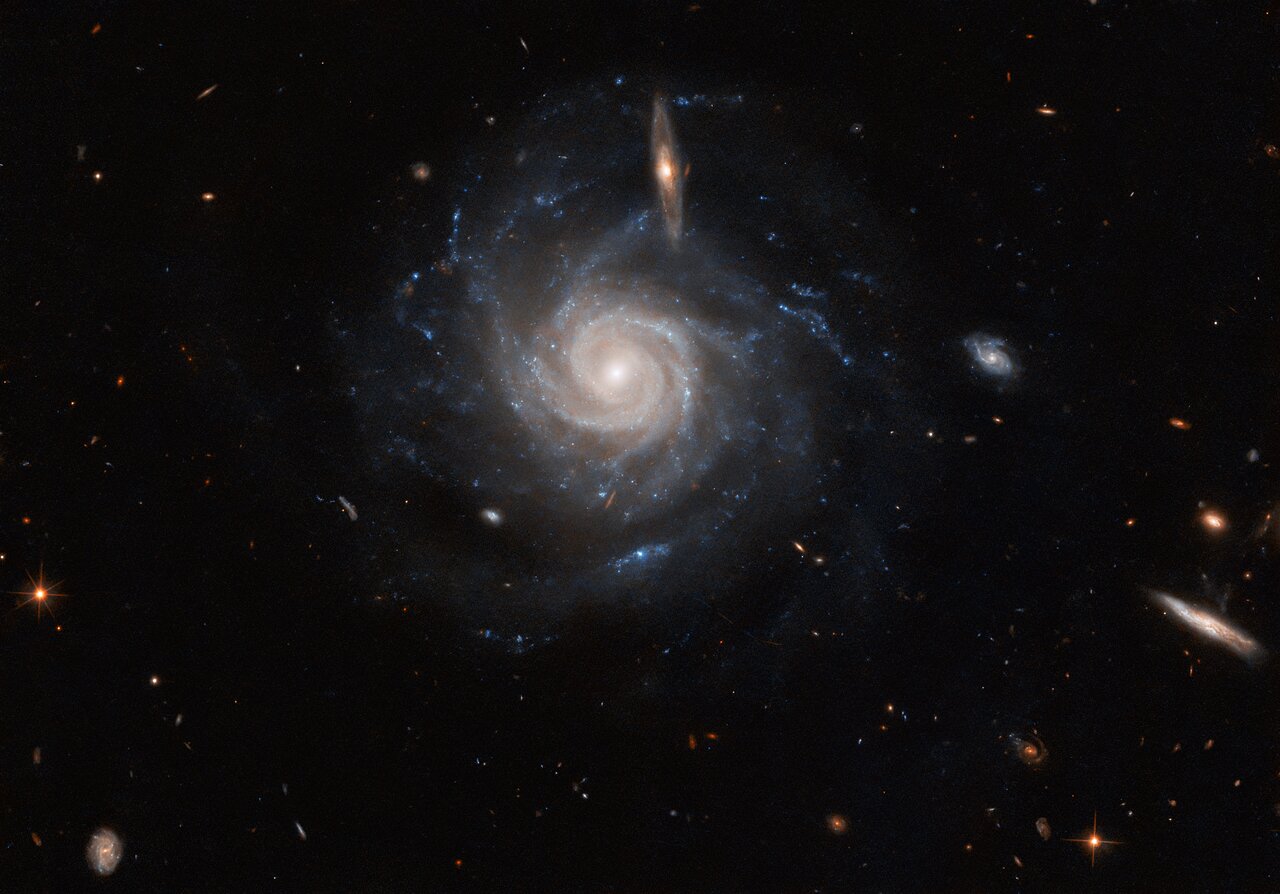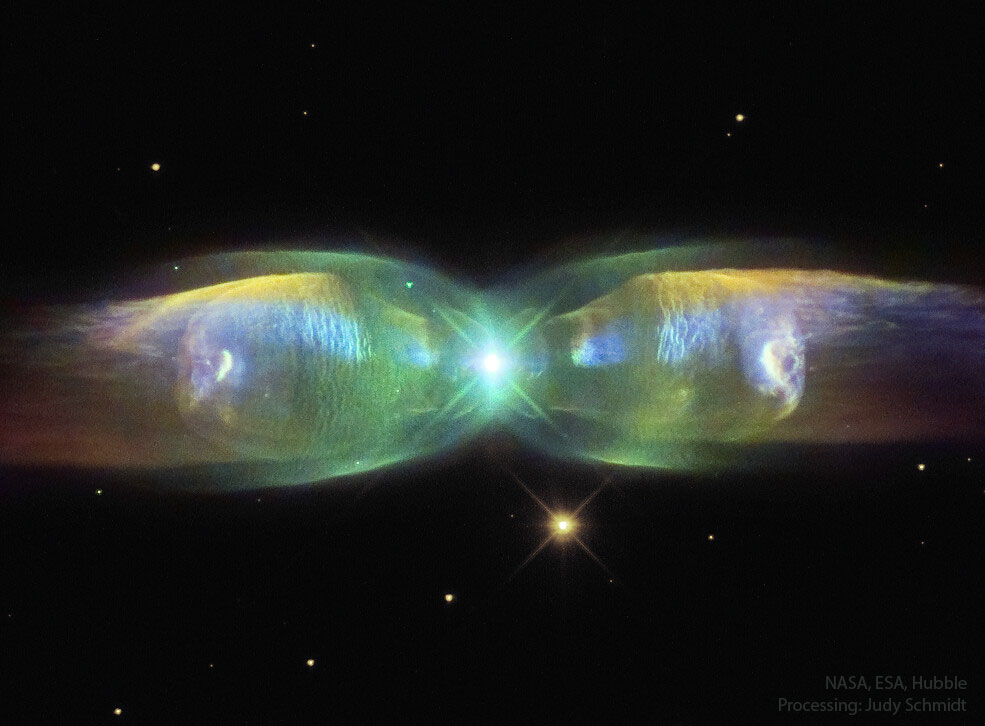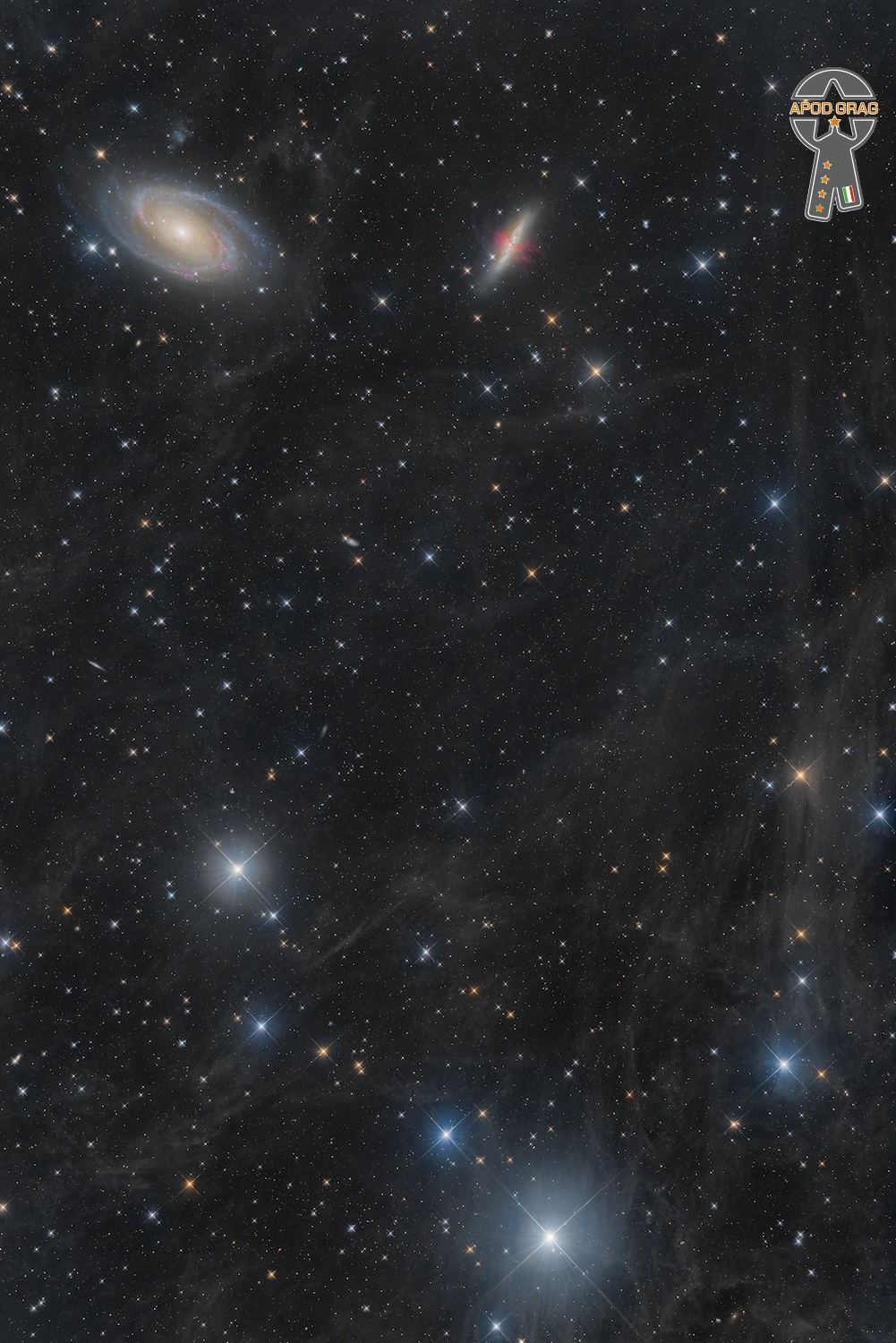Blog
The barred spiral galaxy UGC 678 takes centre stage in this image from the NASA/ESA Hubble Space Telescope. The spectacular galaxy lies around 260 million light-years from Earth in the constellation Pisces and is almost face on, allowing its lazily winding spiral arms to stretch across this image. In the foreground, a smaller edge-on galaxy seems to bisect the upper portion of UGC 678. Just like humans, stars have a natural lifecycle; they are born, grow up, and eventually grow old and die. Studying this stellar life cycle — usually referred to as stellar evolution — is an important topic for astronomers. The ends of star lives can be marked by truly spectacular events, including titanic supernova explosions, the creation of unimaginably dense neutron stars, and even the birth of black holes. UGC 678 was recently found to be host to one of these events; in 2020 a robotic telescope scanning the night sky in search of dangerous asteroids discovered evidence of an enormous supernova explosion in the galaxy. Two separate Hubble observations turned to UGC 678 to scour the galaxy in search of the aftermath of its supernova explosion. One team of astronomers used Hubble’s Advanced Camera for Surveys, and the other the Wide Field Camera 3, but both aimed to explore UGC 678 in the hope of unearthing clues to the identity of the star that produced the 2020 supernova. [Image Description: A large spiral galaxy. It has many narrow arms that are tightly-twisted in the centre, but at the ends they point out in different directions. The galaxy’s core glows brightly, while its disc is mostly faint, but with bright blue spots throughout the arms. A few smaller spiral galaxies at varying angles are visible in front, and it is surrounded by other tiny stars and galaxies, on a black background.]

Jan Hammer (born 17 April 1948) is a Czech-American musician, composer, and record producer. He first gained his most visible audience while playing keyboards with the Mahavishnu Orchestra during the early 1970s, as well as his film scores for television and film including “Miami Vice Theme” and “Crockett’s Theme“, from the 1980s television program Miami Vice. He has continued to work as both a musical performer and producer.
Hammer has collaborated with some of the era’s most influential jazz and rock musicians such as John McLaughlin, Jeff Beck, Billy Cobham, Al Di Meola, Mick Jagger, Carlos Santana, Stanley Clarke, Tommy Bolin, Neal Schon, Steve Lukather, and Elvin Jones. He has composed and produced at least 14 original motion picture soundtracks, the music for 90 episodes of Miami Vice and 20 episodes of the television series Chancer.
His compositions have won him several Grammy Awards.
more...Charles Anthony “Buster” Williams (born April 17, 1942) is an American jazz bassist. Williams is known for his membership in pianist Herbie Hancock‘s early 1970s group, working with guitarist Larry Coryell from the 1980s to present, working in the Thelonious Monk repertory band Sphere and as the accompanist of choice for many singers, including Nancy Wilson.
Williams’ father, Charles Anthony Williams Sr., was a musician who played bass, drums, and piano, and had band rehearsals in the family home in Camden, New Jersey, exposing Williams to jazz at an early age. Williams was particularly inspired to focus on bass after hearing his father’s record of Star Dust, performed by Oscar Pettiford, and started playing in his early teens.
more...Johnny St. Cyr (April 17, 1890 – June 17, 1966) was an American jazz banjoist and guitarist. For banjo his by far most used type in records at least was the six string one. On a famous “action photo” with Jelly Roll Morton’s Red Hot Peppers he is holding a four string banjo, probably tenor. There is, however, no verified information if he ever used such an instrument on records.
St. Cyr was born in New Orleans, Louisiana and raised Catholic. He played for several leading New Orleans bands before moving to Chicago in 1923. He is best remembered as a member of Louis Armstrong’s Hot Five and Hot Seven bands. He also played with Jelly Roll Morton‘s Red Hot Peppers.He composed the standard “Oriental Strut”, known for its adventurous chord sequence.
During the 1950s, he performed and led a group named Johnny St. Cyr and His Hot Five and recorded with Paul Barbarin and George Lewis. From 1961 until his death in 1966, St. Cyr was the bandleader of the Young Men from New Orleans, who performed at Disneyland. He died in Los Angeles, California, and is buried in Evergreen Cemetery, in Los Angeles.
more...THE DEFEAT OF JESSE JAMES world premier Opening Saturday April 29th 730pm at the History Theater in St Paul. mick will be holding the percussion chair in the band. 
Are stars better appreciated for their art after they die? Actually, stars usually create their most artistic displays as they die. In the case of low-mass stars like our Sun and M2-9 pictured here, the stars transform themselves from normal stars to white dwarfsby casting off their outer gaseous envelopes. The expended gas frequently forms an impressive display called a planetary nebula that fades gradually over thousands of years. M2-9, a butterfly planetary nebula2100 light-years away shown in representative colors, has wings that tell a strange but incomplete tale. In the center, two stars orbit inside a gaseous disk 10 times the orbit of Pluto. The expelled envelope of the dying starbreaks out from the disk creating the bipolar appearance. Much remains unknown about the physical processes that cause and shape planetary nebulae. 
Henry Mancini (/mænˈsiːni/ man-SEE-nee; born Enrico Nicola Mancini, Maple Hys, Ohio April 16, 1924 – June 14, 1994) was an American composer, conductor, arranger, pianist and flautist. Often cited as one of the greatest composers in the history of film, he won four Academy Awards, a Golden Globe, and twenty Grammy Awards, plus a posthumous Grammy Lifetime Achievement Award in 1995.
more...Herbert Jay Solomon (April 16, 1930 – July 1, 2003), known by his stage name Herbie Mann, was an American jazz flute player and important early practitioner of world music. Early in his career, he also played tenor saxophone and clarinet (including bass clarinet), but Mann was among the first jazz musicians to specialize on the flute. His most popular single was “Hi-Jack“, which was a Billboard No. 1 dance hit for three weeks in 1975.
Mann emphasized the groove approach in his music. Mann felt that from his repertoire, the “epitome of a groove record” was Memphis Underground or Push Push, because the “rhythm section locked all in one perception.”
Herbie Mann was born in Brooklyn, New York, New York, to Jewish parents Harry C. Solomon (May 30, 1902 – May 31, 1980), who was of Russian descent, and Ruth Rose Solomon (née Brecher) (July 4, 1905 – November 11, 2004), of Romanian descent who was born in Bukovina, Austria-Hungary but immigrated to the United States with her family at the age of 6.
more...John Wesley Funchess (April 16, 1931 – February 1, 1994) known professionally as John (or Johnny) Littlejohn, was an American electric blues slide guitarist. He was active on the Chicago blues circuit from the 1950s to the 1980s.
Born in Lake, Mississippi, Littlejohn first learned to play the blues from Henry Martin, a friend of his father’s. In 1946 he left home and traveled widely, spending time in Jackson, Mississippi; Arkansas; Rochester, New York; and Gary, Indiana. He settled in Gary in 1951, playing whenever possible in the nearby Chicago area. Through his connections in Gary, he was acquainted with Joe Jackson, the patriarch of the musical Jackson family, and Littlejohn and his band reputedly served as an occasional rehearsal band for the Jackson 5 in the mid- to late 1960s.
Littlejohn played regularly in Chicago clubs (he was filmed by drummer Sam Lay playing with Howlin’ Wolf‘s band about 1961) but did not make any studio recordings until 1966, when he cut singles for several record labels.Later that year he recorded an album for Arhoolie Records and four songs for Chess Records. The Chess tracks were not issued at the time.
He recorded a few singles for small local labels but did not record another album until 1985, when Rooster Bluesissued So-Called Friends. Soon after, he fell into ill health. He died of renal failure in Chicago, on February 1, 1994, at the age of 62.
more...Located in the constellation Ursa Major, the galaxies M81 and M82 are about 12 million light-years away from us. The galaxies are on the same plane, only about 120,000 light-years apart.
M81 and M82 are gravitationally interacting. The resulting tidal forces deform M82 and cause violent stellar activity.
The IFN present in the image are not part of the same local group, but rather belong to our Milky Way.

Samuel McClain (April 15, 1943 – June 15, 2015), billed as Mighty Sam McClain, was an American soul blues singer and songwriter.
He was born in Monroe, Louisiana. As a five-year-old, he began singing in his mother’s Gospel Church. McClain left home when he was thirteen and followed local R&B guitarist, Little Melvin Underwood through the Chitlin’ Circuit, first as his valet and then as lead vocalist himself at 15.
While singing at the 506 Club in Pensacola, Florida he was introduced to the record producer and DJ, Papa Don Schroeder and in 1966, McClain recorded a cover version of Patsy Cline‘s “Sweet Dreams”. Several recording sessions at Muscle Shoals produced the further singles, “Fannie-May” and “In the Same Old Way”.
more...David William Edmunds (born 15 April 1944) is a Welsh singer-songwriter, guitarist and record producer. Although he is mainly associated with pub rock and new wave, having many hits in the 1970s and early 1980s, his natural leaning has always been towards 1950s-style rock and roll and rockabilly.
Edmunds was born in Cardiff, Wales. As a ten-year-old, he first played in 1954 with a band called the Edmunds Bros Duo with his older brother Geoff (born 5 December 1939, Cardiff); this was a piano duo. Then the brothers were in the Stompers, later called the Heartbeats, formed around 1957 with Geoff on rhythm guitar, Dave on lead guitar, Denny Driscoll on lead vocals, Johnny Stark on drums, Ton Edwards on bass and Allan Galsworthy on rhythm.
more...Richard Davis (born April 15, 1930) is an American jazz bassist. Among his best-known contributions to the albums of others are Eric Dolphy’s Out to Lunch!, Andrew Hill’s Point of Departure, and Van Morrison’s Astral Weeks, of which critic Greil Marcus wrote (in The Rolling Stone Illustrated History of Rock and Roll), “Richard Davis provided the greatest bass ever heard on a rock album.” Born in Chicago, Illinois, United States, Davis began his musical career with his brothers, singing bass in his family’s vocal trio. He studied double bass in high school with his music theory teacher and band director, Walter Dyett. He was a member of Chicago Youth Symphony Orchestras (then known as the Youth Orchestra of Greater Chicago) and played in the orchestra’s first performance at Chicago’s Orchestra Hall on November 14, 1947.
more...Annapurna Devi (1927 – 13 October 2018) was an Indian surbahar (bass sitar) player of Hindustani classical music. She was given the name ‘Annapurna’ by former Maharaja Brijnath Singh of the former Maihar Estate (M.P.), and it was by this name that she was popularly known. She was the daughter and disciple of royal court musician Allauddin Khan and Madina Bibi, and the first wife of the sitar player Ravi Shankar. After her separation from Ravi Shankar, she moved to Bombay and never performed again in public. She remained a private person, yet continued to teach music for free. Her students include many notable disciples including Hariprasad Chaurasia, Nityanand Haldipur and Nikhil Banerjee.
more...More Posts
- Björk
- Fairuz
- Charlie Palmieri
- Coleman Hawkins
- World Music Ustad Nusrat Fateh Ali Khan
- Daily Roots Scientist
- Einstein Nationalism
- Cosmos Undulatus Clouds
- Dr John
- Clifton “Skeeter” Best
- Duane Allman
- Meredith Monk
- World Fusion Annarella Sörlin & Django Diabaté
- Daily Roots Scientist
- Persecution of Freedoms
- Mother Teresa Hunger
- Einstein Religion
- Cosmos NGC 281
- José Molina
- Henry Medress